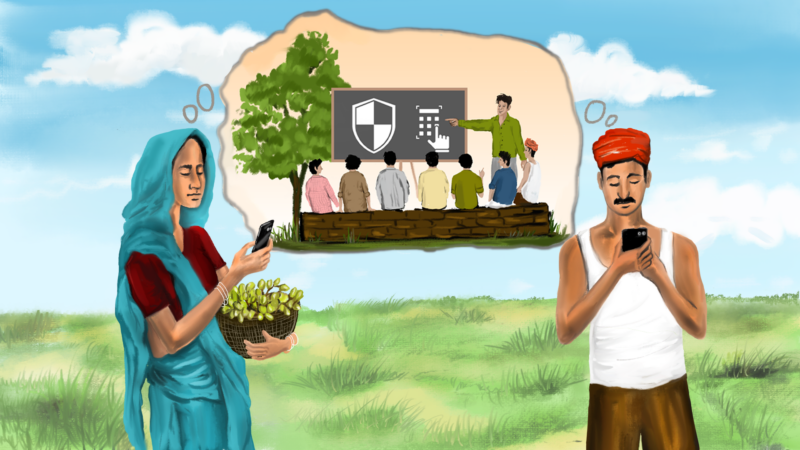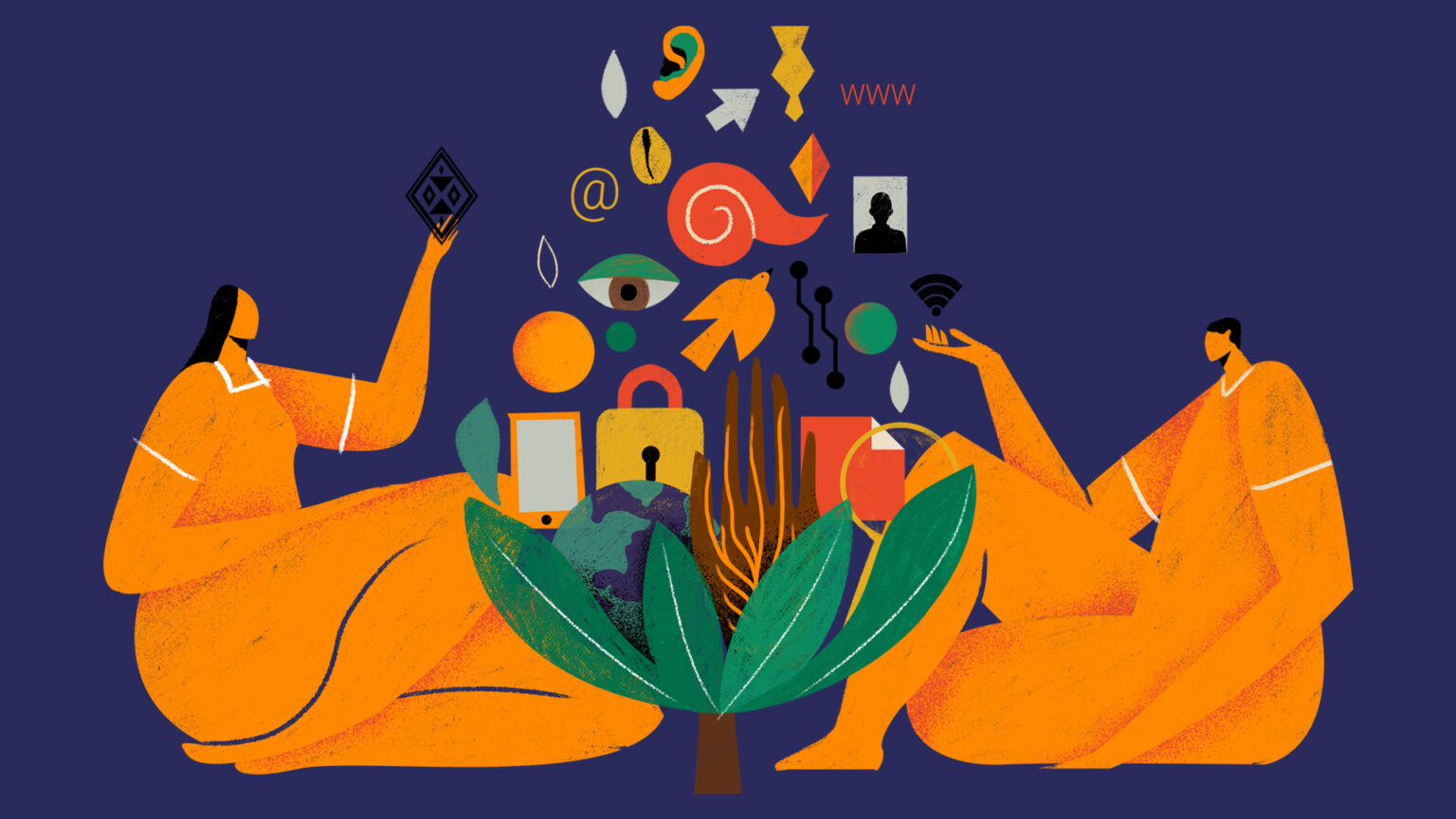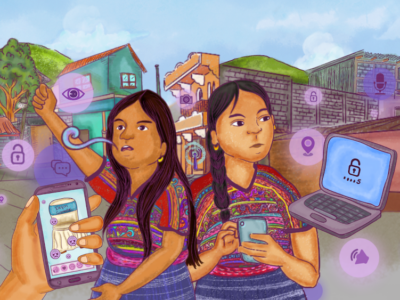
Illustration by Pranav Kumar for Rising Voices
A version of this article is also available in Angika
India has grown rapidly in terms of number of mobile phone and internet users in the past decade. As of October 2021, there were 700 million internet users, 600 million smartphones and the highest mobile data consumption rate globally. Also, the country was reported as the second most cyber-attacked country in Asia Pacific in 2020. Are these widely-used technologies designed for the diversity of users and the hundreds of languages spoken in the country? How are Indigenous users managing to feel secure in the digital world or learning about digital security? These are some of the questions I decided to explore as an Angika speaker.
The language at a glance
“Angika is mainly spoken in south-eastern Bihar, including Munger, Bhagalpur and Banka districts; and the Santhal Pargana division of Jharkhand. Its speakers number around 15 million people. Apart from Bihar and Jharkhand states of India, it is also spoken in the Morang district of Nepalese Terai as a minority language.” — Wikipedia
Recognition: Second language status in Jharkhand state in India
Language status: 5 (Developing) – The language is in vigorous use, with literature in a standardized form being used by some though this is not yet widespread or sustainable.The language is used in education, work, mass media, and government within major administrative subdivisions of a nation.” — EGIDS scale, Ethnologue
Digital security resources in this language:
- None identified
Digital security tools in this language:
- Signal ❌
- TOR ❌
- Psiphon ❌
I was born and brought up in Bihar, and I am a native speaker of Angika. Growing up there I witnessed the social, linguistic, and technological changes in this hamlet. About two decades ago, only a handful of people had any digital devices in their homes, only few could speak Hindi, and “running away” was the term used for young people who had migrated to large cities in search of more profitable work. Nowadays, almost every home has a mobile phone, people (especially young ones) prefer to speak in Hindi outside the domestic space, and migrating to another location upon adulthood has become the norm.
In my observation, it is the availability of mobile phones and internet that has brought about some of the shifts, by making this remote area more connected to the outside world. The use of mobile phones for communication and entertainment is notable, in stark contrast to the lack of facilities like running water, electricity, and opportunities for higher education and stable employment. Cyber crimes are also quite frequent and people often fall prey to hacking and scam calls from untraceable numbers that convince people to give up One Time Passwords (OTPs). Institutional efforts institutional to solve the crimes seem inadequate. What needs to change, then, to make the digital space welcoming for people from all walks of life, in a country growing fast in terms of the number of mobile phone and internet users?
With this question in mind, I decided to undertake research to learn from young farmers who are from Tonapathar and Katoria villages in Bihar. I wanted to understand how a community manages digital security or lack of it, focusing on factors like languages, digital literacy and the online presence of young Angika speakers. With support from the Rising Voices team, conducting research helped establish dedicated time for observation, interviews and the collection of facts, experiences, and perceptions to investigate assumptions regarding their digital activity. What I learned from this research is helpful in understanding the digital safety and security needs of Angika speakers since it is an insider’s perspective.
Learning from young Angika speakers
I interviewed 13 young Angika speakers (17-30 years of age), to gain a deeper and clearer understanding of what can be done differently to make digital facilities a safe and inclusive space for them. I also wanted to understand their motivation for connecting to the internet, their sense of priorities around digital security, and how they navigate the digital space with the language and facilities that they have.
All participants were farmers or have a family background in farming, since the economy of the village is dependent upon agriculture, which makes the research representative of the area. The term “farmer” here means a person who survives by farming, and either owns a small patch of land or is landless. These participants are indispensably below the poverty line of India and belong to the Bahujan community, a spectrum of people consisting of Scheduled Castes, Scheduled Tribes, Other Backward Castes, Muslims and minorities in India (all participants belong to either of the first three categories). This detail is to be noted since land ownership has historically been dictated by caste and birth in this part of the country. Though zamindari (mass land ownership) was abolished in India in 1951, the privilege of the land-owning castes has continued in the form of social and cultural privilege, which the Dalits and Bahujans have systematically been denied.
Another factor that I considered while researching is that of gender, since gender norms in the area are orthodox. For instance, it is customary for women to veil their heads in front of elder males of the household; married women are called by their husband’s or child’s name instead of their own names. For instance, a woman who is married to a man named Shankar would be called “Shankarok janani” (Shankar’s wife), or a mother to a boy named Rupesh would be called “Rupesh maay” (Rupesh’s mother), and usage of their actual names is usually avoided except for in documents. Furthermore, women are expected to become invisible in public places; they are also discouraged from working outside the household. The context of caste and gender matter since they impact an individual’s presence and activity in digital practices as well, as I will discuss below.
Digital security, a luxury in English
Through the conversations with participants, I found that young Angika speakers have begun to abandon their language. Absence of content in their language, whether informational or entertaining, is further damaging the language and the community. Also, word-of-mouth is a major medium to spread information as the news media are either remote or inaccessible to most people because of educational and linguistic gaps. For instance, the remote location of the villages means that newspapers are not usually accessible, so reading the newspaper is not a habit for the residents. People are also reluctant to trust news online, believing only information that comes from those close to them. As a language activist, I realized during the interviews that one of the reasons young people are abandoning their language is that they find it unusable on digital platforms.
While working class people in villages can access mobile phones and the internet, digital security is a luxury. The lack of access to education and information on digital security in the local language are crucial factors that make them even more vulnerable to digital threats. That the participants tend to think of digital safety as one more fancy term they couldn’t understand goes to show how lacking in digital literacy the region is. As a young farmer said: “I do not know about social media rules. I don't really know, since I am not so concerned with it. I lead a life of hands-to-mouth, so these things do not matter to us.”
From the 13 people that participated in this research, 7 reported having experienced mobile phone scams and/or social media hacking. Some of the ways that these scams take place: scammers pose as bankers, as telemarketers, and they hack whatsapp numbers to extract money from the contacts. The victims remain largely unaware of strategies to deal with them, especially because the current methods of digital safety awareness are available only in dominant languages. This holds true in case of social media hacking as well, the affected people are usually unable to retrieve their account. This is not unexpected information considering that the participants learn about digital safety mostly from their family and acquaintances, and even their learning about operating the phone is from them, which in the words of a participant is only kaamchaltau (makeshift).
I also consider that there is a belief in the inferiority of one’s language among my people, as a result of the internalization of largely-held fallacious beliefs. Neglecting linguistic diversity while aiming for a more secure digital environment is going to be unsuccessful and repressive to many indigenous speakers. Some people even believe that the strategy should be teaching people English. However, I find that an impractical idea stemming from the belief that learning English is the key to a more secure life.
Moreover, the imposition of Hindi over the linguistically diverse state Bihar has negatively impacted us. There are several incorrect beliefs towards our languages, some of the most prominent being that our language is inferior and that it is a dialect of Hindi. The latest National Education Policy 2020 reflects the root of this belief. It considers the native languages to be the “bridge languages” to be taught at primary level, after which the students would have to learn the socio-economically empowered languages — Hindi and English. Another factor is the fact that young people usually have to migrate to other regions, where local languages are disparaged. For example, my parents migrated to Jharkhand for a few years, where I was schooled. There I experienced first-hand the bias against Angika and other indigenous languages inside schools and social settings.
Currently, there are no online resources in Angika about digital safety and security, which obviously puts monolingual Angika speakers at a disadvantage. From my perspective, it is clear that people would be able to make sense of the digital space and remain safe if they were able to decipher it, in which language plays a large part. When asked which language awareness programs should be held in, a participant said: “Angika would be better (for training on digital security). English and Hindi would be understood only by those who understand those languages. If it is in the local language, everyone would be able to understand.”
It is also to be noted that the voices of the marginalized, Bahujan community and women, are usually not visible, and they are left out of the possibility of online and offline participation. Participants who have a background in farming have minimum opportunities of employment and education, which negatively impacts their access to information on digital security. In addition, women are doubly marginalized. The digital space here is a reflection of society and women’s activity online is impacted by their gender identity. Some observations about women internet users from this case study: there are fewer internet users, they do not use their own names on social media, not because they prefer to use pseudonyms but to ensure their invisibility. Also, they are more readily blamed if their account is hacked, and they are dependent on the men of the house for information on digital security.
Recommendations
We need inclusive strategies for a safe digital space drive to be successful in the Anga region of Bihar and India in general. While mobile phone and internet connections are thriving in India, the government needs to take accountability by preventing dangers that people are potentially put in with an increased use of the internet. To do that, I think, the major change required is that policymakers in India recognize the linguistic diversity of India.
I consider the following recommendations to ensure that Bihar, with 88.82 percent rural households (who have less access to facilities), does not further fall prey to digital inequalities are:
- Prioritization of digital safety awareness in the local language with local tools.
- Design and conduction of awareness programs in the medium preferred by people. For example, the majority of the participants claim to prefer in-person training in the local language over video training for the awareness programs. The means usually taken to spread awareness, like SMSes and Pradhan Mantri Digital Suraksha Abhiyan, have been unsuccessful in delivering results.
- Efforts towards digital security should be done keeping caste and gender in mind, since these factors impact people’s digital safety habits and awareness.
- Need for change in policies, preventing the use of homogeneous solutions for all of India which excludes disadvantaged populations.
Using one’s language and utilizing digital technology in a safe and secure manner do not have to be in disagreement with each other, especially considering how people increasingly use the internet and mobile phones to communicate and socialize. As language activists, we also have a responsibility to understand the needs of people in the digital domain, making people aware that the linguistic and digital safety rights are to be strived for.
For more stories and information from participating language communities, please visit the “Digital Security + Language” project page



